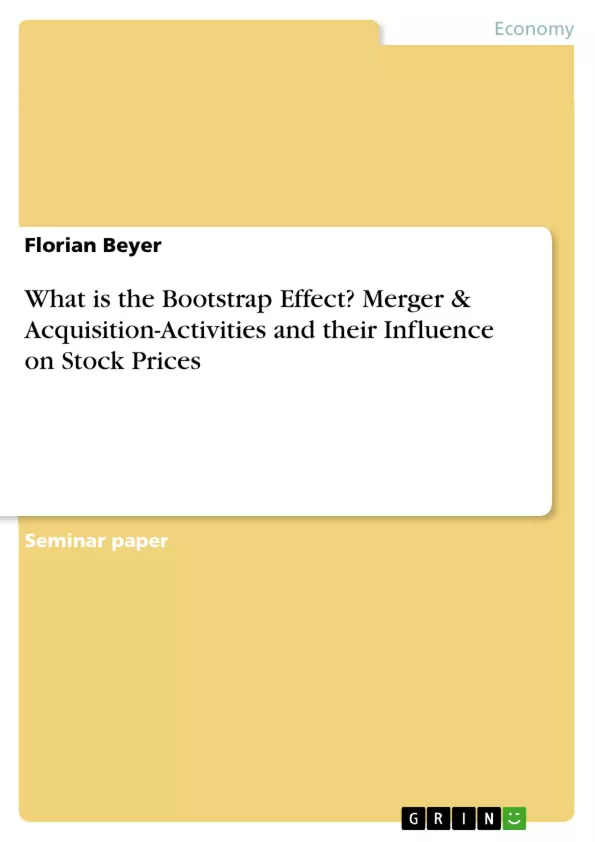This paper will examine the question of how M&A activities influence a company’s stock price and earnings per share (EPS), especially if the bootstrap effect occurs?
In 2016, the global mergers and acquisitions (M&A) activities decreased by about 18 percent compared to 2015. Altogether, 17,369 deals with a value of 3.2 trillion (tn.) US-Dollars (USD) were performed. There are numerous reasons to invest and divest in inorganic growth. Organic growth has its limitations, thus acquiring competitors, growing vertically or horizontally as well as accessing new markets are strong motivators to do so. Growing a business is often linked with going public. The decision to be part of the stock market and to perform M&A influences an enterprise’s value for various reasons.
To approach these questions, the first chapter gives a general overview of reasons, motivators, risks and benefits of M&A. Thereafter, the influence of M&A on a company’s shareholder value and EPS is examined. Then, the bootstrap effect is explained and subsequently illustrated by an exemplary M&A transaction. Afterwards the risks and benefits of bootstrapping and M&A are analysed to consider its usefulness and influence on the share price and EPS.
Table of Contents
- 1 Introduction
- 2 Mergers & acquisitions at a glance
- 3 Mergers & acquisitions' influence on the share price
- 3.1 Influence of takeover announcements
- 3.2 Shareholder value approach
- 3.3 Calculation of the shareholder value
- 4 The bootstrap effect
- 4.1 Account of the bootstrap effect
- 4.2 Appliance of the bootstrap effect
- 4.3 Consequences for mergers and acquisitions
- 5 Conclusion
Objectives and Key Themes
This study aims to investigate the influence of mergers and acquisitions (M&A) activities on stock prices, particularly focusing on the "bootstrap effect." The analysis utilizes a shareholder value approach, exploring how takeover announcements impact share price and how the bootstrap effect can be applied in the context of M&A.
- Influence of M&A on stock prices
- Shareholder value approach in M&A
- The bootstrap effect in M&A
- Consequences of the bootstrap effect for M&A
- Application of the bootstrap effect
Chapter Summaries
- Chapter 1: Introduction This chapter provides an overview of the topic and outlines the research objectives. It highlights the relevance of understanding the influence of M&A on stock prices, particularly the impact of the bootstrap effect.
- Chapter 2: Mergers & acquisitions at a glance This chapter offers a concise overview of mergers and acquisitions, providing a foundational understanding of these corporate strategies. It highlights key aspects and relevant concepts related to M&A.
- Chapter 3: Mergers & acquisitions' influence on the share price This chapter delves into the impact of M&A on stock prices, specifically examining the influence of takeover announcements. It also introduces the shareholder value approach as a framework for analyzing M&A, including a detailed explanation of calculating shareholder value.
- Chapter 4: The bootstrap effect This chapter focuses on the bootstrap effect, a phenomenon that can occur in M&A. It provides an account of the bootstrap effect, outlines its application in M&A, and explores its consequences for these activities.
Keywords
Key terms and concepts central to this study include mergers & acquisitions (M&A), stock prices, takeover announcements, shareholder value, bootstrap effect, free cash flow, weighted average cost of capital (WACC), and earnings per share (EPS).
- Quote paper
- Florian Beyer (Author), 2017, What is the Bootstrap Effect? Merger & Acquisition-Activities and their Influence on Stock Prices, Munich, GRIN Verlag, https://www.grin.com/document/536597



